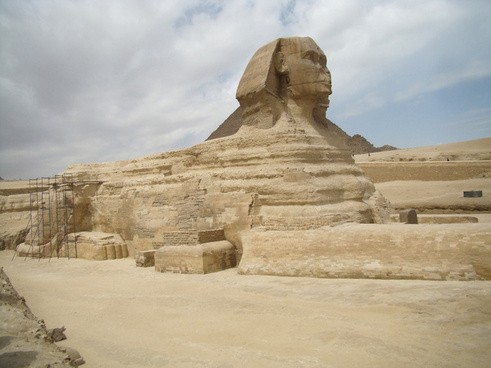The Course of Egyptian History

Historians have divided Egyptian
history into three major periods, known as the Old Kingdom, Middle Kingdom, and
New Kingdom . These periods were times of
stability. Between these periods were times of chaos and invasion, known as
intermediate periods.
Egyptian
history begins around 3100 BCE, when King Menes united Upper and Lower Egypt into one kingdom. King Menes also created the
first dynasty. A dynasty is a family of rulers who’s right to rule is passed on
within the family.
The
Old Kingdom lasted from about 2700 to 2200
BCE. It was a time of prosperity and splendor. The monarchs of the Old Kingdom were powerful rulers. The most common title for Egyptian monarchs
was pharaoh. The word pharaoh originally meant “great house” or “palace.” The
Egyptians believed that pharaohs were gods. By obeying their pharaoh, they
believed that they were helping to keep their world stable. Pharaohs had
unlimited power to rule their people, but they developed a bureaucracy to help
them rule. A bureaucracy is an administrative organization with officials and
regular procedures. The most important official was the vizier (“the steward of
the whole land”). He reported directly
to the pharaoh and was in charge of the government bureaucracy.
One
of the greatest achievements of Egyptian civilization was the building of the
pyramids. This took place during the Old Kingdom .
Pyramids were tombs for the bodies of dead pharaohs. The tombs were stocked
with food and other supplies. The Egyptians believed that human beings had two
bodies, a physical one and a spiritual one. The spiritual body was called the ka. If the physical body was preserved
after death and its tomb and its tomb was stocked with food and supplies, the ka could return. To preserve the
physical body after death, the Egyptians used mummification. Mummification is
the process of slowly drying a dead body to prevent it from rotting.
The
largest of the pyramids was built at Giza
The
Old Kingdom eventually collapsed. It was
followed by a period of chaos that lasted about 150 years. Around 2050 BCE, a
new dynasty gained control of Egypt Egypt conquered Nubia
and sent armies to Syria and
Palestine Red Sea .
This aided trade and transportation.
The
Middle Kingdom ended around 1652 BCE, when the Hyksos invaded Egypt Asia who used horse-drawn chariots.
They ruled Egypt
Eventually
a new dynasty of pharaohs used the new skills and weapons to drive out the
Hyksos. The New
Kingdom lasted from about 1567 to 1085 BCE. During the period of
the New Kingdom, Egypt
created an empire and became the powerful state in Southwest
Asia . The pharaohs of the New Kingdom
built new temples. Hatshepsut, the first woman to become a pharaoh, built a
great temple at Deir el Bahri, near Thebes
There
were also problems during the New Kingdom . The
pharaoh Amenhotep IV forced the people to worship a single god, Aton. He closed
the temples of the other gods, and changed his name to Akhenaton (“it is well
with Aton”). After he died, the new pharaoh, Tutankhamen, restored his old
gods. But the problems caused by Amenhotep’s changes led to a loss of Egypt
Under
Ramses II, the Egyptians tried to regain control of their earlier empire, but
they were only partly successful. During the thirteenth century BCE, “Sea
Peoples” invaded the Egyptian Empire and it came to an end. The New Kingdom itself ended in 1085 BCE.
For
the next thousand years, Libyans, Nubians, Persians, and Macedonians dominated Egypt Egypt Egypt
became part of the Roman Empire .











Post a Comment